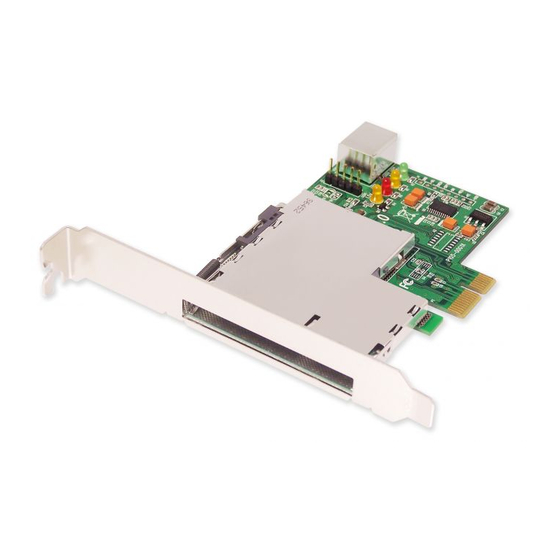
Table of Contents
Advertisement
Quick Links
PCIe to ExpressCard Adapter
Quick Installation Guide
Introducing the PCIe to ExpressCard
The PCIe to ExpressCard Adapter is the perfect solution for
computer users who wish to share ExpressCard devices
between their notebook and desktop systems.
Features and Benefits
•
Compliant with USB specification rev. 2.0
•
Hot-plug and hot-swap support allows for you to
connect/detach devices without turning off the
system (USB-based ExpressCard devices only)
•
Works with ExpressCard/54 and ExpressCard/34
form factor cards
•
Works with Broadband Modems, I/O adapters
(e.g.1394a/b), EV-DO data cards, flash memory,
flash card adapters, security, legacy I/O (PS2,
serial, parallel), optical disk drives, GPS receivers
and more
System Requirements
•
PC with an available PCI Express slot
•
Windows 2000/XP/Server 2003/Vista
Package Contents
•
PCIe to ExpressCard Adapter
•
USB cable
•
Quick Installation Guide
04-0449A
1
Advertisement
Table of Contents

Summary of Contents for SIIG PCIe to ExpressCard Adapter
-
Page 1: Quick Installation Guide
PCIe to ExpressCard Adapter Quick Installation Guide Introducing the PCIe to ExpressCard The PCIe to ExpressCard Adapter is the perfect solution for computer users who wish to share ExpressCard devices between their notebook and desktop systems. Features and Benefits •... - Page 2 Layout Type-B USB USB Pin-out Header Connector ExpressCard slot Figure 1. Board Layout Note: Connecting to the USB Pin-out Header is recommended. Do not connect the USB Pin-out Header and Type-B USB Connector at the same time. Connecting both at the same time may damage the ExpressCard adapter and system.
-
Page 3: Usb Cable Connection
PCIe to ExpressCard Pin-out Header DATA - DATA + Pin 1 (+5VDC) Figure 3. PCIe to ExpressCard Pin-out Header USB Cable Connection Pin 1 (+5VDC) Figure 4. USB Cable Connection Note: Match up Pin 1 (+5VDC) on the USB cable connector to Pin 1 (+5VDC) on the card's pin-out header. - Page 4 Motherboard USB Pin-out Header The typical internal USB Pin-out Header found on motherboards consists of 9 pins arranged in 2 rows; each header provides 2 USB ports. Match up +5VDC (Pin 1) on the USB Cable Connector to Pin 1 or Pin 2 on the pin-out header.
- Page 5 No driver installation is needed. Type-B USB Connector This connector provides an alternate method to connect to the USB host adapter. The PCIe to ExpressCard Adapter can be connected to an internal USB port (Type-A) through the Type-B USB Connector. This connection requires a USB cable which must be purchased separately.
- Page 6 Inserting/Removing ExpressCard PCI Express-based ExpressCard Devices PCI Express-based ExpressCard devices are not hot-plug/hot-swap compatible through this adapter. Insert a PCI Express-based ExpressCard before startup or restart the computer after inserting the card. To insert, position the ExpressCard on the left •...
-
Page 7: Technical Support And Warranty
This product comes with a lifetime manufacturer warranty. Please see SIIG website for more warranty details. If you should happen to have any problems with this product, follow the procedures below. A) If it is within the store's return policy period, please return the product to the store where you purchased from. - Page 8 6078 Stewart Ave. Fremont, CA 94538-3152 PCIe to ExpressCard Adapter is a trademark of SIIG, Inc. SIIG and SIIG logo are registered trademarks of SIIG, Inc. Microsoft and Windows are registered trademarks of Microsoft Corporation. Other names used in this publication are for identification only and may be trademarks of their respective companies.














Need help?
Do you have a question about the PCIe to ExpressCard Adapter and is the answer not in the manual?
Questions and answers